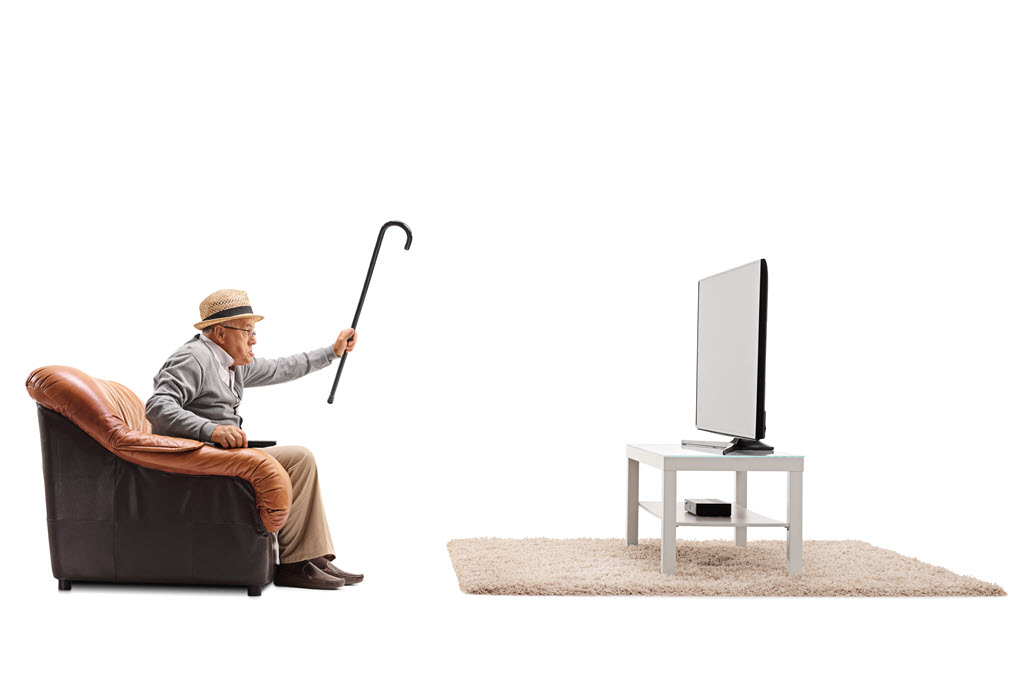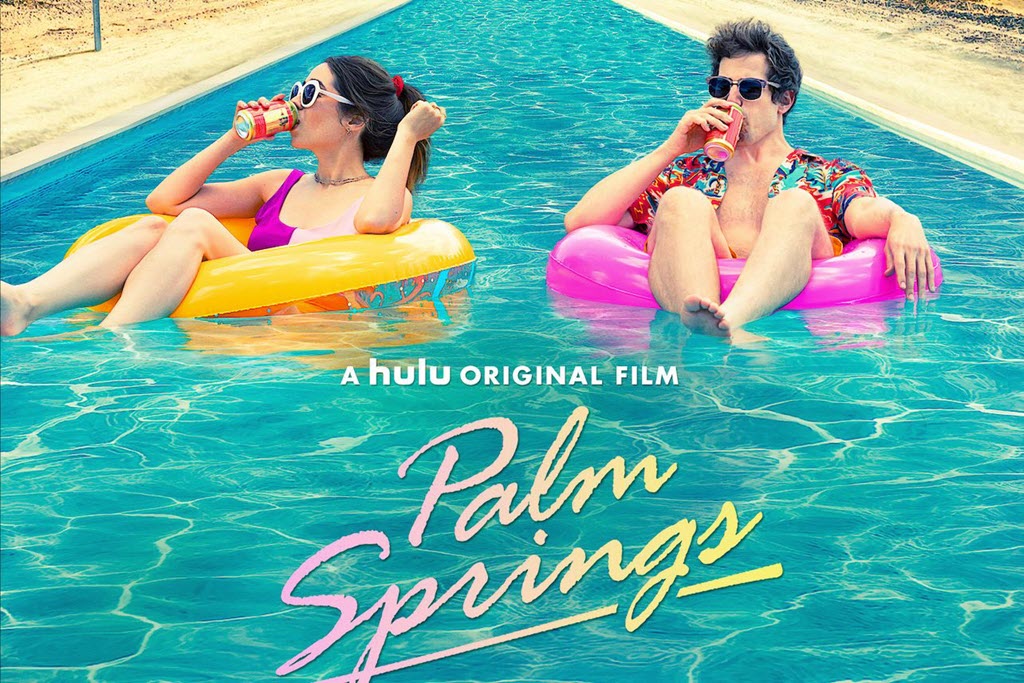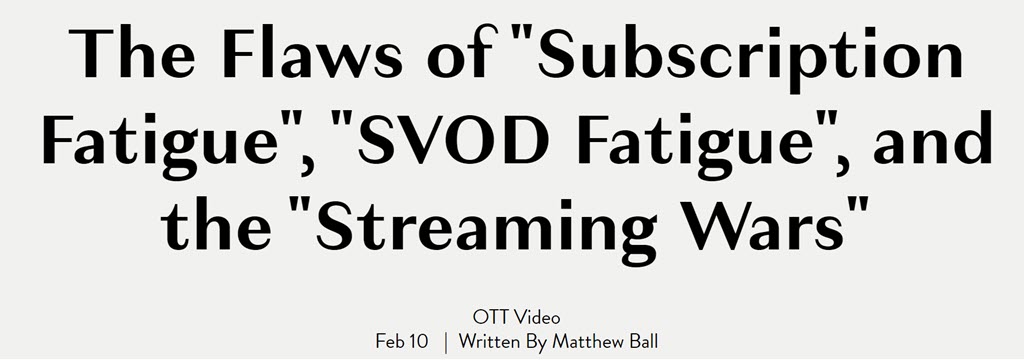
There are a lot of video streaming services.
During the years when cable TV ruled the earth, all of us complained about the pricing of the bundles pushed by the cable companies. “I just want to watch The Daily Show! How unfair that I have to pay for a bundle that also includes the Monster Truck channel and the Judge Judy Anime channel!”
We clamored for disaggregation. We thought we wanted more choices.
Well, we’ve got more choices. I’m not sure we’re happier.
There are more than 100 video streaming services in the United States. Each of them requires a separate monthly payment. Frequently the monthly amount is small, five dollars a month or so, the cost of a cappuccino, each one just a little additional weight on the budget scale. But they add up! When you consider a few more things – the services are confusing and not well defined, and frequently annoying – it’s easy to imagine that you’re running into new pain points. You can be forgiven if you’re feeling nostalgic for the good old days when a single cable guide would show you what was on and let you change the channel to watch it.
You’re familiar with a few of the established names. Netflix, of course. Amazon Prime Video, included with the annual Amazon Prime subscription you got originally for “free” shipping. Maybe you signed up for HBO so you could watch Game of Thrones. Hulu is an easy way to get lots of TV shows. If you’re a parent, you likely got some relief from Disney+ this year. (Hard-core Star Wars fans jumped on Disney+ to ooh and ah at Baby Yoda, but things are a little slow in the Star Wars universe now that you’ve finished The Mandalorian.)
Starting in the 1920s, during the “Golden Age of Hollywood,” eight major studios marketed themselves and built the studios’ reputations just as much as they promoted individual movies. Moviegoers might choose to go to an RKO horror movie or MGM musical without knowing anything about it based on their faith in the studio.
The streaming services act as if they can recapture 1920s Hollywood magic. The primary services are built and advertised around megacorporations, not around anything thematic that would help you choose one or another. You have no idea what would distinguish Peacock from CBS All Access, or Showtime from Vudu or Starz. They’ll only come to your attention when you discover that something you want to watch is locked up behind a paywall. There are more paywalls all the time.
Disney is the only major studio with a strong identity today. The rest are a blur of megacorporations making similar content. Yet we’re forced to allocate our entertainment budget based on our opinion of the libraries owned by Warners, Universal, Sony, CBS, Netflix, Amazon, or HBO.
It’s impossible to know where to watch something. There are slightly dodgy websites like JustWatch where you can find out where to watch a movie or TV show – yet another URL to remember. I only subscribe to three services, but that’s enough to leave me unsure what to click when I sit down. It irritates me to hunt through the Netflix lists before I remember that the show I’m watching is on Amazon.

Want to see the next Tom Hanks movie? Not so fast! It will be an exclusive on Apple TV+. Interested in a new romantic comedy with Andy Samberg? The trailer makes it look awesome. But it will only be available to Hulu subscribers. Did you enjoy Some Good News, the series of YouTube videos that John Krasinski put out to get us through the pandemic? He sold the rights to the concept and will only be peripherally involved going forward. (He said he never intended to do more than eight episodes because he’s very busy. Hmm. Maybe.) The interesting thing that you might not have noticed is that the revived show will be locked behind the paywall for CBS All Access, whatever that is.
Okay, imagine that you become used to the idea of dribbling out money for multiple streaming services. You’re prepared to miss the movies and TV shows on services you don’t subscribe to. You’re not done! You still have the confusion of too many choices and poor branding, plus the possibility that your TV may not connect to some services.
For a few days in June, HBO was mocked for the disastrous rollout of a rebranding of its various streaming options. The paragraphs I’m about to write will look like gibberish. Don’t worry about the details. The point is that one of the best-known video services is promoting choices that are quite literally incomprehensible.
Here’s the summary:
HBO Now is HBO’s streaming service in the US, with different prices depending on how you obtain it. HBO Go is also a streaming service from HBO; it has the same content as HBO Now, but it’s only available to people with a cable TV subscription to HBO, and also with different prices for different cable providers.
In the original announcement, HBO Max was presented as a new streaming service from HBO, with exactly the same content but also lots more stuff than HBO Now and HBO Go. It costs the same as HBO Now unless it costs something different because you get it in a bundle from another provider. If you’re an HBO Now or HBO Go subscriber, you’ll be upgraded to HBO Max, unless you’re not, because it might not be available if you bought HBO Now or HBO Go from some third parties – notably Amazon, which didn’t cut a deal with HBO, and some cable providers.
For some reason, people found that difficult to follow, so HBO decided to “address brand confusion.” HBO Go is going to be retired. HBO Now is being renamed to HBO. Lots of people will be upgraded to HBO Max, which is different from HBO, which is the new name for HBO Now, except for the people who won’t be upgraded because megacorporations don’t actually like us.
There’s another wrinkle. Many people don’t know how streaming video gets to their TVs, and that’s another potential pain point. If you settle on HBO Max, say, you still won’t be able to watch it if your TV is connected to a Roku or an Amazon Fire TV stick, because HBO didn’t cut a deal with them. Those two devices account for nearly two-thirds of all viewing time among streaming boxes.
That’s just HBO. Admittedly a bad rollout, but things aren’t that much better with the other services. More than one hundred other services. Some of them are aimed at niche audiences, just like the old niche cable channels – Crunchyroll for anime, Twitch for gamers, a variety of sports channels, Criterion for classic movies, Hallmark Movies for horror. Number 73 on the list is “Poker Go,” which can’t be what it sounds like, can it? Oh god, it is. What an interesting world.

I think “subscription fatigue” is a pretty useful term to sum up annoyance and frustration and the tiredness when I sit down and realize I have no idea how to watch something I have in mind. Maybe it’s not the right term. Here’s an extended business analysis of why it’s a poorly chosen term. The gist seems to be that we can’t be fatigued because differentiation is swell, and we must be happy because we’re all going to spend lots of money on this content, so what are we all bitching about anyway? I’m paraphrasing. And I’m not convinced, because I know I’m pretty tired of the whole thing, and there are many more services to come.

I tried to go legit with streaming, I subscribed to Netflix for several years but then the fragmentation started to happen and I went back to buying used DVDs and downloading content from torrents. Netflix was great when it was a one stop shop but I’m not going to subscribe to 10 different services. It has become too complicated and it’s not even worth the effort to figure out anymore.